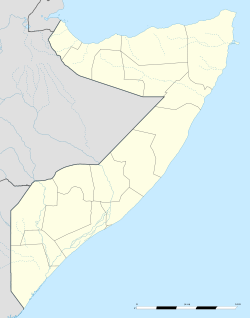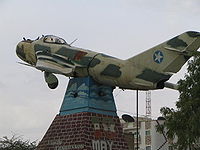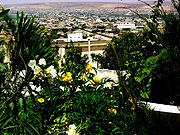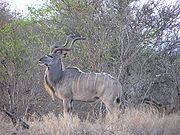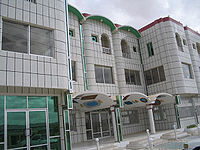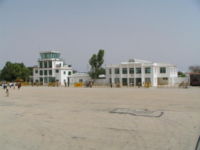
Hargeisa
Background to the schools Wikipedia
This content from Wikipedia has been selected by SOS Children for suitability in schools around the world. A good way to help other children is by sponsoring a child
| Hargeisa Hargaysa هرجيسا |
|
|---|---|
| Central Hargeisa at dusk. | |
|
|
|
| Coordinates: 9°30′N 44°0′E | |
| De facto state | |
| De jure state | |
| Region | Somaliland |
| Sub-Region | Maroodi Jeex |
| Granted capital status | 1941 ( British Somaliland) |
| 1960 ( State of Somaliland) | |
| 1991 (Somaliland) | |
| Government | |
| • Mayor | Mudane Hussain Mohammoud Jiciir |
| Elevation | 1,326 m (4,350 ft) |
| Population | |
| • Total | 1,300,000 |
| • Density | 15/km2 (40/sq mi) |
| Time zone | EAT ( UTC+3) |
| Languages | Somali, Arabic and English |
| Religion | Sunni Islam |
| Website | Hargeisa New Site Old Site |
Hargeisa ( Somali: Hargaysa, Arabic: هرجيسا) is the largest city and capital of Somaliland, a de facto independent republic that is internationally recognized as a part of Somalia. It was the colonial capital of British Somaliland from 1941 to 1960 when it gained independence as the State of Somaliland and united with Italian Somaliland to form the Somali Republic.
History
Prehistoric inhabitants
The city is home to Neolithic cave paintings recently discovered named Laas Geel. The cave paintings are situated on the outskirts of the city, located around a plethora of granite alcoves and rocky mountains. The paintings show ancient inhabitants of the area worshipping cattle. It also shows animals which are commonly seen in the region primarily antelopes, camels and early dogs. The Laas Geel cave paintings were discovered in November 2002 by a French archaeological team. They contain some of the earliest known art in the Horn region and Africa in general, dating back to somewhere between 8,000 and 9,000 BCE.
British Somaliland
In 1888, after signing successive treaties with the then ruling Somali Sultans such as Mohamoud Ali Shire of the Warsangali Sultanate, the British established a protectorate in the region referred to as British Somaliland. The British garrisoned the protectorate from Aden in present-day Yemen, and administered it from their British India colony until 1898. British Somaliland was then administered by the Foreign Office until 1905 and afterwards by the Colonial Office.
Berbera, a major trading harbour on the Red Sea, was the protectorate's first capital due to its strategic importance. However, the capital was moved from Berbera to Hargeisa, and the city was granted capital status in 1941. During the East African Campaign, the protectorate was occupied by Italy in August 1940, but recaptured by the British in March 1941. The protectorate gained its independence on 26 June 1960. Days later, the country was unified with Italian Somaliland to form a new Somali Republic (Somalia) on 1 July 1960.
1980s events
Due to the Barre regime's violent repression, Somalis in the northwestern part of the country (particularly the Isaaq clan), encouraged by Ethiopia in opposition to Somalia, took up arms and formed the Somaliland National Movement (S.N.M.) in 1981 to resist Barre. In the late 1980s, Barre virtually lost control of the province and ordered the air force to bomb Hargeisa, today's capital of Somaliland. The bombing and subsequent raids of government troops claimed tens of thousands of casualties.
A war memorial in the form of a MiG fighter jet was erected in Hargeisa to mark this event.
Reconstruction
As control of Mogadishu shifted in favour of the United Somali Congress (USC) in 1991, a power struggle between the leaders had led to the city's destruction. While Mogadishu and the rest southern Somalia were being destroyed, the opposite was happening in Hargeisa and the rest of northwestern Somalia. By 18 May, 1991, secessionists in the Somaliland region had declared independence and reconstruction had begun.
Since 1991, the city has undergone a massive facelift and over 99% of devastated commercial and residential homes have now been rebuilt and in better condition than before the war. Remittance money sent from overseas relatives contributed tremendously in the reconstruction of the city as well as entrepreneurial spirit of local residents and citizens throughout the Somaliland region.
Hargeisa has working traffic lights and traffic laws are respected. All residents entitled to drive must hold a photo driving license. All cars bear Somaliland license plates.
Geography
Hargeisa is located in a valley in the western section of the country. The city is in a mountainous area because it is situated in an enclosed valley of the Galgodon (Ogo) highlands, at an elevation of 1,334 meters (4,377 ft) above sea level. This altitude gives Hargeisa and the surrounding area a milder climate than the Gulf of Aden coastal area (one of the hottest areas on earth) and the Hargeisa region has a fairly equable climate. The temperature ranges between 13 and 32 degrees Celsius (55 and 89 degrees Fahrenheit).
Hargeisa receives larger amounts of rain, and used to be surrounded by forest when the city was smaller but the countryside around the city still has small juniper forests. Near Hargeisa are the fertile Sheikh and Daallo mountains, which also receive large amount of rain. South of Hargeisa is the Sahaley Savannah which attracts many different animals to graze in the area
Hargeisa is also close to another town in northwestern Somalia called Arabsiyo. It is a major farming and agricultural area and it falls into the main boundaries of Hargeisa.
Wildlife
Due to its fertility and greenery, wild animals (e.g. zebras) come to the Hargeisa area to either breed or graze on the grassland savannah. Animals that can be found in Hargeisa include the Kudu, wild boar, Somali Wild Ass, warthogs, antelopes, the Somali sheep, wild goats, camels and many different types of birds. South of Hargeisa is a grassland savannah, which attracts many types of wildlife to the area including lions and leopards.
Economy
Hargeisa is the financial hub to many entrepreneurial industries ranging from food processing, gem stonecutters, construction, retail, import and export, Internet cafes, and companies that process remittances from relatives abroad who send money. Some families have moved back to the city, living in mansions in the hills during the summer.
Hargeisa city is the namesake of Hargeisa Minerals & Resources Company and contains many of Somaliland's business Headquarters in its city limits.
The city also has a private and public menageries, it houses animals from the region including lions, leopards, antelopes, birds and reptiles.
Transport
The city is home to Hargeisa International Airport, with flights to Addis Ababa, Djibouti City, Dubai and many other cities across Africa and Somalia. All foreigners are required to exchange 50 US Dollars to local currency (which is the Somaliland Shilling. (1 USD=6700 Somaliland Shillings in Open market as of April 2009, Official rate is almost half of the open market). There are local bus services in Hargeisa. There are also other buses and shared taxis that goes to other cities in Somaliland.
Paved roads are available in Hargeisa, however most have been badly damaged by tanks and shelling during the war. The vast majority of the roads were paved by the British, during colonial rule. The local government has repaired some of the roads but many others are still awaiting repair.
Buses are the most commonly used form of public transport in the city. They travel on a number of routes serving nearly all districts of the city. Intra-city bus services are available connecting the major towns and cities like Burao, Berbera and Borama to Hargeisa.
Taxis are available, but are a less common form of public transport.
Education
In Hargeisa, there are several colleges and some universities; the main ones includes University of Hargeisa, Admas University College, Somaliland University of Technology and Gollis University.
The Edna Adan Maternity Hospital offers nursing programmes.
There are also several state-run and privately owned secondary and high schools including Abaarso Tech, the premiere secondary school in the capital region. In addition, many primary schools and nurseries are dispersed all around the city.
Students receive instruction from teachers who have studied abroad or from teachers who were educated prior to the Somali Civil War.
Communication
Hargeisa has a modern telephone system and nearly everyone in the city enjoys a telephone and some with access to the internet. Internet cafes are dotted all around Hargeisa and many youngsters and adults benefit from this. Mobile communication services are available in Hargeisa. The main mobile communication services in Hargeisa are operated by Telesom, Nationlink Somaliland, Soltelco Telcom and Somtel

